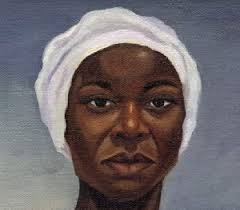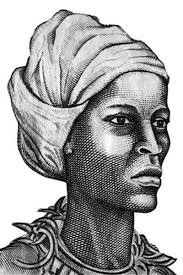Queen Nanny, Granny Nanny, or Nanny of the Maroons was an early-18th-century freedom fighter and leader of the Jamaican Maroons. She led a community of formerly-enslaved escapees, the majority of them West African in descent, called the Windward Maroons, along with their children and families. At the beginning of the 18th century, under the leadership of Nanny, the Windward Maroons fought a guerrilla war lasting many years against British authorities in the Colony of Jamaica, in what became known as the First Maroon War.
Nanny was also known as Granny Nanny, Grandy Nanny was a Maroon leader and Obeah woman in Jamaica during the late 17th and early 18th centuries. Maroons were slaves in the Americas who escaped and formed independent settlements. Nanny herself was an escaped slave who had been shipped from Western Africa. It has been widely accepted that she came from the Ashanti tribe of present-day Ghana.

Nanny and her four brothers (all of whom became Maroon leaders) were sold into slavery and later escaped from their plantations into the mountains and jungles that still make up a large proportion of Jamaica. Nanny and one of her brothers, Quao, founded a village in the Blue Mountains, on the Eastern (or Windward) side of Jamaica, which became known as Nanny Town. Nanny has been described as a practitioner of Obeah, a term used in the Caribbean to describe folk magic (voodoo) and religion based on West African influences.
Queen Nanny became a folk hero among the Maroons and the slaves. While the British captured Nanny Town on more than one occasion, they were unable to hold on to it, in the wake of numerous guerrilla attacks from the Maroons. The Maroons waged a successful war against the British colonial forces over the course of a decade.
In one Maroon story, Nanny came to Jamaica as a slave but then escaped, perhaps even jumping off of the ship while it was offshore, while her sister Sekesu was enslaved. The legend states that Queen Nanny became mother of all Maroons and her sister Sekesu became mother of all enslaved in Jamaica. The oral traditions about her arrival in Jamaica maintain that she was always free, while Sekesu eventually died free in the mountains with Nanny.
In another story, she came as a free woman who may have even had her own slaves. Another version of her life tells that she was of royal African blood and came to Jamaica as a free woman. She may have been married to a Maroon man possibly named Adou, and had one Son name Kwashkwaku, nicknamed Granfara Puss. Relatives of poet John Agard claim descent from Nanny.
According to one Maroon legend, Nanny’s name was also Sarah “Matilda” Rowe, but that has not been verified. The Rowe family of Jamaica claim direct descent from Nanny. According to oral history, her second husband was named Swipplemento, later known by the Anglicized name of Rose Harris, affectionally called Pa Rose then Pa Ro, Queen Nanny was known as Shanti Rose or Ma Ro. Oral tradition states that Ro eventually became anglicized as Rowe, though many Maroons of the late 18th century changed their African names for European ones, as they converted to Christianity. Maroon legend states that Nanny was known to have gone by the name Sarah, and sometimes Matilda. Oral history states that she had three children with Swipplemento; two sons Kojo Rowe and Ampong Rowe, and a daughter called Nanny as well.
In 1655, following the Invasion of Jamaica, the English captured Jamaica from the Spaniards, but many Spanish slaves became free under Spanish Maroon leaders such as Juan de Bolas and Juan de Serras. The Spanish left, freeing their slaves in the process, and they joined the Windward Maroon communities. These formerly enslaved people, with their ranks enhanced with escaped and liberated slaves, became the core of the Windward Maroons. They staged a prolonged fight against English subjugation and enslavement. Later in the 17th century, more slaves escaped joining the two main bands of Windward and Leeward Maroons. By the early 18th century, these Maroon towns were headed respectively by Nanny, who shared the leadership of the eastern Maroons with Quao, and Captain Cudjoe and Accompong in the west. The Windward Maroons fought the British on the east side of the island from their villages in the Blue Mountains of Portland.
The community raised animals, hunted, and grew crops. Maroons at Nanny Town and similar communities survived by sending traders to the nearby market towns to exchange food for weapons and cloth. It was organized very much like a typical Asante society in Africa. From 1655 until they signed peace treaties in 1739 and 1740, these Maroons led most of the slave rebellions in Jamaica, helping to free slaves from the plantations. They raided and then damaged lands and buildings held by plantation owners.
The Maroons were also known for raiding plantations for weapons and food, burning the plantations, and leading freed slaves to join their mountain communities. Nanny was highly successful at organizing plans to free slaves. During a period of 30 years, she was credited with freeing more than 1000 slaves, and helping them to resettle in the Maroon community.
The Windward Maroons succeeded against a much superior and better armed enemy. One of their advantages over the British was their long-range communications capability. They pioneered the use of a cow horn called an abeng. This horn with a hole drilled in one end was used for long range communications. Its signals allowed Maroon lookouts to communicate over great distances, and they were not understood by the British who had no similar communications capability.

Nanny’s troops were masters of camouflage. The soldiers were so proficient at disguising their location that the British would circulate tales of trees in the forest becoming alive and cutting one’s head off. Besides the physical aspects of camouflage, the Maroons became experts in slowing their breathing so as not to reveal their presence to someone in their vicinity. The maroons also developed ways of creating stealthy fires that were not readily visible.
Look out for the full story on Queen Nanny in our upcoming Magazine.




